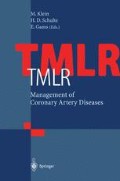Abstract
The use of lasers to create transmyocardial channels in hibernating myocardium is being considered as an alternative for patients who cannot be treated with ordinary bypass surgery. The physiological mechanism behind the therapy is not yet understood and is still hard to prove in studies. Although the idea of transmyocardial revascularisation (TMR) started with the perfusion concept of a reptile heart [1], the functioning might also be ascribed to neoplastic revascularisation of the hibernating myocardium [2]. At the basis of the biological response is the creation mechanism of the channel. Therefore, it is beneficial to study and understand the working mechanism of the creation of channels by the various lasers currently being use [3]. With this knowledge it is possible to control the characteristics of the channels, depending on the laser parameters. Based on earlier experience [4], it is believed that the channels for transmyocardial laser recanalisation (TMLR) should meet the following conditions: the channels for ‘reperfusion’ should be about 15–25 mm long and 1 mm in diameter. For minimal invasive treatment, the channels should be created on a beating heart within the diastolic phase (<100 ms) or on an arrested heart using multiple pulses. Long-term patency is expected when the walls of the channels have minimal thermal damage.
Access this chapter
Tax calculation will be finalised at checkout
Purchases are for personal use only
Preview
Unable to display preview. Download preview PDF.
References
Kohmoto T, Argenziano M, Yamamoto N, Vliet KA, Gu A, Derosa CM, Fisher PE, Spotnitz HM, Burkhoff D, Smith CR (1997) Assessment of transmyocardial perfusion in alligator hearts. Circulation 95:1585–1591
Whittaker P, Rakusan K, Kloner RA (1996) Transmural channels can protect ischemic tissue assessment of long-term myocardial response to laser-made and needle-made channels. Circulation 93:143–152
Jansen ED, Frenz M, Kadipasaoglu KA, Pfefer TJ, Altermatt HJ, Motamedi M, Welch AJ (1997) Laser-tissue interaction during transmyocardial laser revascularization. Ann. Thorac Surg 63:640–647
Sachinopoulou A, Beek JF, Tukkie R, Meijer DW, Gründeman PF, de Mol BAJM, Bannenberg J, Verdaasdonk RM, van Gement MJC (1996) Transmyocardial Revascularisation Lasers Med Sci 10:83–91
Moosdorf R, Maisch B, Hoffken H (1996) Transmyocardial laser revascularization - limits and possibilities. Z Kardiol 85 [Suppl 6]:281–285
Horvath KA, Cohn LH, Cooley DA, Crew JR, Frazier OH, Griffith BP, Kadipasaoglu K, Lansing A, Mannting F, March R, Mirhoseini MR, Smith C (1997) Transmyocardial laser revascularization: results of a multicenter trial with transmyocardial laser revascularization used as sole therapy for end-stage coronary artery disease. J Thorac Cardiovasc Surg 113:645–653
Verdaasdonk R (1995) Imaging laser induced thermal fields and effects. In: Jacques (ed) Laser-tissue interaction. VI. Bellingham. SPIE proc. vol. 2391, pp 165–175
Verdaasdonk RM, Jansen ED, Holstege FC, Borst C (1991) Mechanism of CW Nd:YAG laser recanalization with modified fiber tips: influence of temperature and axial force on tissue penetration in vitro. Lasers Surg Med 11:204–212
Borst C, Jansen EW, Tulleken CA, Gründeman PF, Mansvelt Beck HJ, van Dongen JW, Hodde KC, Bredee JJ (1996) Coronary artery bypass grafting without cardiopulmonary bypass and without interruption of native coronary flow using a novel anastomosis site restraining device (“Octopus”). J Am Coll Cardiol 27:1356–1364
Gründeman PF, van Leeuwen TG, Verdaasdonk RM, Jansen EWL, Mansvelt Beck H, Borst C (1996) Thoracoscopic creation of transmural laser channels in the beating porcine heart using conventional lasers: closed chest application of the ‘Octopus’ cardiac immobilization method. [Abstract] Circulation 94:(I)477
Krabatsch T, Schaper F, Leder C, Tulsner J, Thalmann U, Hetzer R (1996) Histological findings after transmyocardial laser revascularization. J Card Surg 11:326–331
Gassier N, Wintzer HO, Stubbe HM, Wullbrand A, Heimchen U (1997) Transmyocardial laser revascularization. Histological features in human nonresponder myocardium. Circulation 95:371–375
Kohmoto T, Fisher PE, Gu A, Zhu SM, Derosa CM, Smith CR, Burkhoff D (1997) Physiology, histology, and 2–week morphology of acute transmyocardial channels made with a CO2 laser. Ann Thorac Surg 63:1275–1283
Kohmoto T, Fisher PE, Gu A, Zhu SM, Yano OJ, Spotnitz HM, Smith CR, Burkhoff D (1996) Does blood flow through holmium YAG transmyocardial laser channels? Ann Thorac Surg 61:861–868
Fleischer KJ, Goldschmidt Clermont PJ, Fonger JD, Hutchins GM, Hruban RH, Baumgartner WA (1996) One-month histologic response of transmyocardial laser channels with molecular intervention. Ann Thorac Surg 62:1051–1058
Kim CB, Kesten R, Javier M, Hayase M, Walton AS, Billingham ME, Kernoff R, Oesterle SN (1997) Percutaneous method of laser transmyocardial revascularization. Cathet Cardiovasc Diagn 40:223–228
Editor information
Editors and Affiliations
Rights and permissions
Copyright information
© 1998 Springer-Verlag Berlin Heidelberg
About this paper
Cite this paper
Verdaasdonk, R., Sachinopoulou, A., Gründeman, P., Beek, J. (1998). Working Mechanism of Pulsed CO2/ Holmium and Excimer Laser Systems with Regard to Transmyocardial Revascularisation (TMR): In Vivo Implications. In: Klein, M., Schulte, H.D., Gams, E. (eds) TMLR Management of Coronary Artery Diseases. Springer, Berlin, Heidelberg. https://doi.org/10.1007/978-3-642-72134-2_12
Download citation
DOI: https://doi.org/10.1007/978-3-642-72134-2_12
Publisher Name: Springer, Berlin, Heidelberg
Print ISBN: 978-3-642-72136-6
Online ISBN: 978-3-642-72134-2
eBook Packages: Springer Book Archive

